Yellowstone Fall Photo Tours
2010
TRIP REPORT
 On our last afternoon, with the sun now hidden behind the ring of mountains, a herd of Bighorn Sheep scrambled along a steep cliff face above the Gardiner River. Some in the herd moved high, but a few literally dropped down for a drink, scrambling and bouncing across the loose scree in a controlled fall. I tried to pan at a slow shutter speed as I followed one lamb streaking down the cliff. One shot, I think, captured that moment, and with it we concluded another wonderful two weeks of Photo Tours in Yellowstone. Here's the details!
On our last afternoon, with the sun now hidden behind the ring of mountains, a herd of Bighorn Sheep scrambled along a steep cliff face above the Gardiner River. Some in the herd moved high, but a few literally dropped down for a drink, scrambling and bouncing across the loose scree in a controlled fall. I tried to pan at a slow shutter speed as I followed one lamb streaking down the cliff. One shot, I think, captured that moment, and with it we concluded another wonderful two weeks of Photo Tours in Yellowstone. Here's the details!
Spectacular coyote opportunities and the best mule deer we’ve ever had characterized both of our two Yellowstone Photo Tours this year. More surprisingly, unseasonably warm temperatures both weeks also defined this year’s trips, and in both the cities of Butte and Billings records were either set or came within a degree or two of past record temperatures, most of which occurred on the same dates just the year before.
This year we were able to push back the two tours by a week, covering the third and fourth weeks of September when, in ‘normal’ years, we could expect frosty temperatures and occasional snows, sometimes even minor blizzards. This year, however, by late morning and throughout the rest of most days we were in shirt-sleeves or T-shirts, and after our first week we shipped our heaviest winter clothing and boots home!


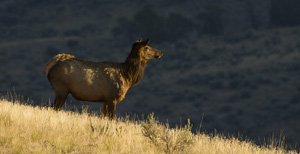
Yellowstone is always changing, and the elk-saturated Park of the past now seems gone forever, as a new ecology has developed, courtesy of the gray wolves reintroduced into the Park. Now, finding and photographing a good bull elk is almost as difficult as finding a moose, but that shortfall doesn’t reduce Yellowstone’s power and incredible photographic opportunities.
 Each of our two trips were different, with unique highlights for each. Shared highlights for both trips included our best Pikas ever, where we photographed this unique mountain rabbit just feet from our picnic breakfast stop. Pikas resemble a chinchilla or fat hamster, but despite their resemblance to a rodent they belong to the Lagomorph family, the rabbits and hares, and unlike rodents, pikas do not hibernate. Instead, throughout the summer and fall they gather flowers, grasses, and leaves, which they store beneath boulders in large, dry hay piles. In the winter, when snow covers the landscape, the pikas feed upon the vegetation they had gathered. Pikas are extremely cryptic, and a motionless pika perched upon a lichen-spotted boulder is almost impossible to see until it moves. This they do often, darting between the rocks and boulders as they commute from their hay larders and their harvesting grounds. This peek-a-boo aspect of seeing and finding a pika is part of their appeal, providing an even greater sense of accomplishment when one finally stops within range for a good shot.
Each of our two trips were different, with unique highlights for each. Shared highlights for both trips included our best Pikas ever, where we photographed this unique mountain rabbit just feet from our picnic breakfast stop. Pikas resemble a chinchilla or fat hamster, but despite their resemblance to a rodent they belong to the Lagomorph family, the rabbits and hares, and unlike rodents, pikas do not hibernate. Instead, throughout the summer and fall they gather flowers, grasses, and leaves, which they store beneath boulders in large, dry hay piles. In the winter, when snow covers the landscape, the pikas feed upon the vegetation they had gathered. Pikas are extremely cryptic, and a motionless pika perched upon a lichen-spotted boulder is almost impossible to see until it moves. This they do often, darting between the rocks and boulders as they commute from their hay larders and their harvesting grounds. This peek-a-boo aspect of seeing and finding a pika is part of their appeal, providing an even greater sense of accomplishment when one finally stops within range for a good shot.
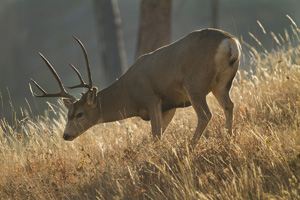
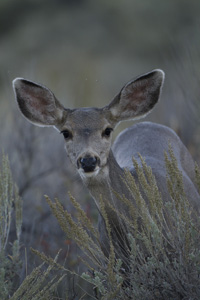
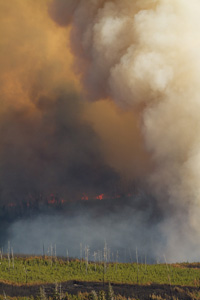 Although Elk are less frequently seen, Mule Deer are becoming more common. Twenty-five years ago, when Mary and I first started doing Yellowstone tours, mule deer were rare, and we were lucky to photograph even one on a trip. Now they are seen frequently, and this year both groups had great opportunities for shooting both small two-point bucks and some broad-beamed trophies. One of my favorite shots of the trips was a nice buck, backlighted in the early morning light and framed by a foggy haze, the product of a massive forest fire to the East.
Although Elk are less frequently seen, Mule Deer are becoming more common. Twenty-five years ago, when Mary and I first started doing Yellowstone tours, mule deer were rare, and we were lucky to photograph even one on a trip. Now they are seen frequently, and this year both groups had great opportunities for shooting both small two-point bucks and some broad-beamed trophies. One of my favorite shots of the trips was a nice buck, backlighted in the early morning light and framed by a foggy haze, the product of a massive forest fire to the East.
On our first tour, one of our customary routes was closed due to a fire that ran across Dunraven Pass quite close to the road. By our second tour that route was open, but another fire started nearby and we spent an afternoon photographing this raging fire from several different vantage points. For our participants who live in the West, seeing the power and destruction and force of a large fire really hit home, and the thought of having a home in range of one of these monsters was truly frightening.
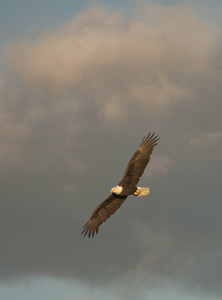
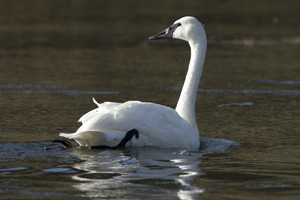


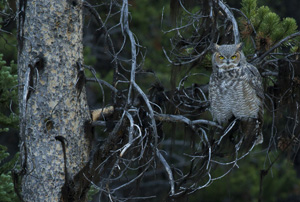
Clockwise, Bald Eagle over Swan Lake, Trumpeter Swan, American Avocet in flight,
Great Horned Owl, and Avocet pair in flight - the first time we've photographed Avocets
in Yellowstone -- there is always something new!
We were told that the Pine Nut crop had failed this year, and bears would be low searching for food. One couple, Suzie and Grover, had a spectacular opportunity to film a Grizzly right next to the road as they drove into the park, but only one of our groups saw a grizzly during the tour, and that one was rather far away.
 We did much better with Black Bears, and on the second tour we lucked into a bear feeding right next to the road at a convenient parking spot. Shortly after we began shooting the bear climbed atop a fallen log to feed upon rose hips, a hard, berry-like fruit that both deer and bears relish. We spent nearly an hour with the bear before it finally wandered off across the sage-brush dotted hillside.
We did much better with Black Bears, and on the second tour we lucked into a bear feeding right next to the road at a convenient parking spot. Shortly after we began shooting the bear climbed atop a fallen log to feed upon rose hips, a hard, berry-like fruit that both deer and bears relish. We spent nearly an hour with the bear before it finally wandered off across the sage-brush dotted hillside.
Although Elk are far less common these days, both groups had good luck. On the first tour we photographed a nice bull resting in the shade of some pines along the Madison, while on the second tour we had our best elk in the hillsides near the Mammoth campgrounds. There, we watched as a bull elk followed one camper around his van, and we expected the elk to ram the van at any moment. It didn't, but incredibly, an unbelievably stupid camper then approached the same elk, shooting it with a small zoom lens. We watched as the elk approached him, while the man continued shooting, seemingly oblivious to how close the elk actually was, which came to within about 8 feet. Luckily for the man, the elk didn’t charge or attack and just walked on past, but we really expected to see a terrible tragedy.
Coyotes were one of the highlights for both trips, and we had a very cooperative coyote that worked a particular stretch of meadow on both tours. South of Hayden we found another that continually worked a field, and in its circuit would pass within minimum focus of our lenses.
Bison were common, and both tours had their own unique opportunities. On the first tour we had a great group of bulls that fed or rested closeby, providing wonderful portrait opportunities in the early morning light. On the second tour we had a large herd cross the Lamar River, and from our vantage point on a nearby hill we had a spectacular panorama of the Lamar Valley, river, and streaming herd of bison crossing the shallow waterway single-file.
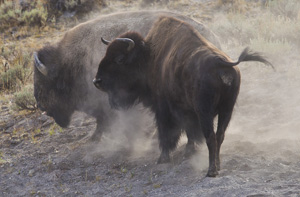

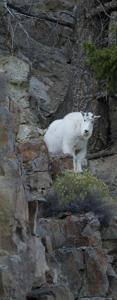


Top Row: Bison in Hayden Valley; a Least Chipmunk
Second Row: Rarely, Mountain Goats are visible in Yellowstone; Pronghorn buck
Also along the Lamar our first tour had a great shoot with Pronghorn, or pronghorn antelope as they were once called. The pronghorn surged around the Lamar, drinking and vexing a herd buck that tried to keep his harem in check. On the second tour pronghorns eluded us until our last day when we first shot a single buck that walked straight to us, and later a courting pair that again came within more-than frame-filling range.
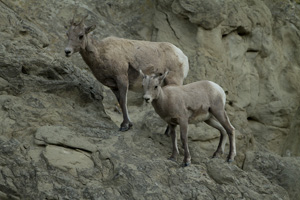 Both groups did well with Bighorn Sheep, and we timed our travels on both tours to arrive at a likely watering spot when the sheep would descend the cliffs to drink. On the first tour we had a large group that fed and browsed quite close to the road, and on the second tour, on our last evening as we were preparing to leave the park, another large group appeared. The light was low and not everyone took advantage of the opportunity, but I saw the bighorns moving to a spot I hoped they’d use to descend to the river and, quite fortunately, several did, speeding down the cliff in an almost uncontrolled plunge
Both groups did well with Bighorn Sheep, and we timed our travels on both tours to arrive at a likely watering spot when the sheep would descend the cliffs to drink. On the first tour we had a large group that fed and browsed quite close to the road, and on the second tour, on our last evening as we were preparing to leave the park, another large group appeared. The light was low and not everyone took advantage of the opportunity, but I saw the bighorns moving to a spot I hoped they’d use to descend to the river and, quite fortunately, several did, speeding down the cliff in an almost uncontrolled plunge
What was truly a delight for Mary and I were our groups, both of which were interested and involved in photographing everything, which of course had to include the wonderful Yellowstone landscapes. Aspens were in varying states of fall color for both groups, and we shot several different groves. Out in Lamar we filmed one group of trees in a location quite close to where we almost always take our groups, but this year, reaching that location earlier in the day, we shot that same locale from an entirely different, and rewarding, angle.
Although I had expectations of shooting some of the geothermal areas in Yellowstone, we never had the time or chance. Our other scenic opportunities, the Yellowstone Grand Canyon, the aspens, the sweeping prairie panoramas, the slow shutter speed river and stream scenes, and more occupied so much of our non-wildlife shooting time that we never reached any of those locations!
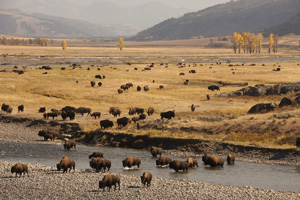
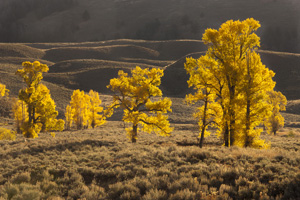
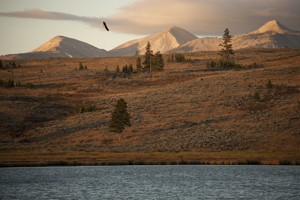
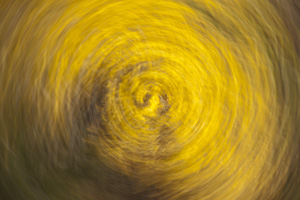
Top: Bison crossing the Lamar River; Aspens in early morning, backlighted.
Second Row: A bald eagle soars over Swan Lake; Aspens 'twirled' at a slow shutter speed.
As usual, we had only a few new people on both tours, so we had the double pleasure of sharing and seeing Yellowstone with photographers who were seeing it for the first time, as well as our enjoyment of sharing the Park with trip veterans and dear old friends. We hated to see either trip end, and we agreed that both weeks went entirely too fast!
As I write this Tour recap at the Bozeman airport, waiting for our flight, I’m smiling as I relive some of these highlights (fortunately in an almost empty lounge, so I don’t appear to be this grinning maniac tucked in a corner) and I can hardly believe that it won’t be for another 50 weeks before I once again get a chance to photograph in this truly magical location. Hopefully some of you that are reading this will join us next year!
Contact us by e-mail at
info@hoothollow.com
Phone (717) 543-6423 Or Fax: (717) 543-5342
About Your Leaders
Contact our Office to REGISTER for this Photo Shoot
Return to HomePage or to photo tours general information.
Yellowstone Fall Photo Tours
2010
TRIP REPORT
 On our last afternoon, with the sun now hidden behind the ring of mountains, a herd of Bighorn Sheep scrambled along a steep cliff face above the Gardiner River. Some in the herd moved high, but a few literally dropped down for a drink, scrambling and bouncing across the loose scree in a controlled fall. I tried to pan at a slow shutter speed as I followed one lamb streaking down the cliff. One shot, I think, captured that moment, and with it we concluded another wonderful two weeks of Photo Tours in Yellowstone. Here's the details!
On our last afternoon, with the sun now hidden behind the ring of mountains, a herd of Bighorn Sheep scrambled along a steep cliff face above the Gardiner River. Some in the herd moved high, but a few literally dropped down for a drink, scrambling and bouncing across the loose scree in a controlled fall. I tried to pan at a slow shutter speed as I followed one lamb streaking down the cliff. One shot, I think, captured that moment, and with it we concluded another wonderful two weeks of Photo Tours in Yellowstone. Here's the details!
Spectacular coyote opportunities and the best mule deer we’ve ever had characterized both of our two Yellowstone Photo Tours this year. More surprisingly, unseasonably warm temperatures both weeks also defined this year’s trips, and in both the cities of Butte and Billings records were either set or came within a degree or two of past record temperatures, most of which occurred on the same dates just the year before.
This year we were able to push back the two tours by a week, covering the third and fourth weeks of September when, in ‘normal’ years, we could expect frosty temperatures and occasional snows, sometimes even minor blizzards. This year, however, by late morning and throughout the rest of most days we were in shirt-sleeves or T-shirts, and after our first week we shipped our heaviest winter clothing and boots home!



Yellowstone is always changing, and the elk-saturated Park of the past now seems gone forever, as a new ecology has developed, courtesy of the gray wolves reintroduced into the Park. Now, finding and photographing a good bull elk is almost as difficult as finding a moose, but that shortfall doesn’t reduce Yellowstone’s power and incredible photographic opportunities.
 Each of our two trips were different, with unique highlights for each. Shared highlights for both trips included our best Pikas ever, where we photographed this unique mountain rabbit just feet from our picnic breakfast stop. Pikas resemble a chinchilla or fat hamster, but despite their resemblance to a rodent they belong to the Lagomorph family, the rabbits and hares, and unlike rodents, pikas do not hibernate. Instead, throughout the summer and fall they gather flowers, grasses, and leaves, which they store beneath boulders in large, dry hay piles. In the winter, when snow covers the landscape, the pikas feed upon the vegetation they had gathered. Pikas are extremely cryptic, and a motionless pika perched upon a lichen-spotted boulder is almost impossible to see until it moves. This they do often, darting between the rocks and boulders as they commute from their hay larders and their harvesting grounds. This peek-a-boo aspect of seeing and finding a pika is part of their appeal, providing an even greater sense of accomplishment when one finally stops within range for a good shot.
Each of our two trips were different, with unique highlights for each. Shared highlights for both trips included our best Pikas ever, where we photographed this unique mountain rabbit just feet from our picnic breakfast stop. Pikas resemble a chinchilla or fat hamster, but despite their resemblance to a rodent they belong to the Lagomorph family, the rabbits and hares, and unlike rodents, pikas do not hibernate. Instead, throughout the summer and fall they gather flowers, grasses, and leaves, which they store beneath boulders in large, dry hay piles. In the winter, when snow covers the landscape, the pikas feed upon the vegetation they had gathered. Pikas are extremely cryptic, and a motionless pika perched upon a lichen-spotted boulder is almost impossible to see until it moves. This they do often, darting between the rocks and boulders as they commute from their hay larders and their harvesting grounds. This peek-a-boo aspect of seeing and finding a pika is part of their appeal, providing an even greater sense of accomplishment when one finally stops within range for a good shot.


 Although Elk are less frequently seen, Mule Deer are becoming more common. Twenty-five years ago, when Mary and I first started doing Yellowstone tours, mule deer were rare, and we were lucky to photograph even one on a trip. Now they are seen frequently, and this year both groups had great opportunities for shooting both small two-point bucks and some broad-beamed trophies. One of my favorite shots of the trips was a nice buck, backlighted in the early morning light and framed by a foggy haze, the product of a massive forest fire to the East.
Although Elk are less frequently seen, Mule Deer are becoming more common. Twenty-five years ago, when Mary and I first started doing Yellowstone tours, mule deer were rare, and we were lucky to photograph even one on a trip. Now they are seen frequently, and this year both groups had great opportunities for shooting both small two-point bucks and some broad-beamed trophies. One of my favorite shots of the trips was a nice buck, backlighted in the early morning light and framed by a foggy haze, the product of a massive forest fire to the East.
On our first tour, one of our customary routes was closed due to a fire that ran across Dunraven Pass quite close to the road. By our second tour that route was open, but another fire started nearby and we spent an afternoon photographing this raging fire from several different vantage points. For our participants who live in the West, seeing the power and destruction and force of a large fire really hit home, and the thought of having a home in range of one of these monsters was truly frightening.





Clockwise, Bald Eagle over Swan Lake, Trumpeter Swan, American Avocet in flight,
Great Horned Owl, and Avocet pair in flight - the first time we've photographed Avocets
in Yellowstone -- there is always something new!
We were told that the Pine Nut crop had failed this year, and bears would be low searching for food. One couple, Suzie and Grover, had a spectacular opportunity to film a Grizzly right next to the road as they drove into the park, but only one of our groups saw a grizzly during the tour, and that one was rather far away.
 We did much better with Black Bears, and on the second tour we lucked into a bear feeding right next to the road at a convenient parking spot. Shortly after we began shooting the bear climbed atop a fallen log to feed upon rose hips, a hard, berry-like fruit that both deer and bears relish. We spent nearly an hour with the bear before it finally wandered off across the sage-brush dotted hillside.
We did much better with Black Bears, and on the second tour we lucked into a bear feeding right next to the road at a convenient parking spot. Shortly after we began shooting the bear climbed atop a fallen log to feed upon rose hips, a hard, berry-like fruit that both deer and bears relish. We spent nearly an hour with the bear before it finally wandered off across the sage-brush dotted hillside.
Although Elk are far less common these days, both groups had good luck. On the first tour we photographed a nice bull resting in the shade of some pines along the Madison, while on the second tour we had our best elk in the hillsides near the Mammoth campgrounds. There, we watched as a bull elk followed one camper around his van, and we expected the elk to ram the van at any moment. It didn't, but incredibly, an unbelievably stupid camper then approached the same elk, shooting it with a small zoom lens. We watched as the elk approached him, while the man continued shooting, seemingly oblivious to how close the elk actually was, which came to within about 8 feet. Luckily for the man, the elk didn’t charge or attack and just walked on past, but we really expected to see a terrible tragedy.
Coyotes were one of the highlights for both trips, and we had a very cooperative coyote that worked a particular stretch of meadow on both tours. South of Hayden we found another that continually worked a field, and in its circuit would pass within minimum focus of our lenses.
Bison were common, and both tours had their own unique opportunities. On the first tour we had a great group of bulls that fed or rested closeby, providing wonderful portrait opportunities in the early morning light. On the second tour we had a large herd cross the Lamar River, and from our vantage point on a nearby hill we had a spectacular panorama of the Lamar Valley, river, and streaming herd of bison crossing the shallow waterway single-file.





Top Row: Bison in Hayden Valley; a Least Chipmunk
Second Row: Rarely, Mountain Goats are visible in Yellowstone; Pronghorn buck
Also along the Lamar our first tour had a great shoot with Pronghorn, or pronghorn antelope as they were once called. The pronghorn surged around the Lamar, drinking and vexing a herd buck that tried to keep his harem in check. On the second tour pronghorns eluded us until our last day when we first shot a single buck that walked straight to us, and later a courting pair that again came within more-than frame-filling range.
 Both groups did well with Bighorn Sheep, and we timed our travels on both tours to arrive at a likely watering spot when the sheep would descend the cliffs to drink. On the first tour we had a large group that fed and browsed quite close to the road, and on the second tour, on our last evening as we were preparing to leave the park, another large group appeared. The light was low and not everyone took advantage of the opportunity, but I saw the bighorns moving to a spot I hoped they’d use to descend to the river and, quite fortunately, several did, speeding down the cliff in an almost uncontrolled plunge
Both groups did well with Bighorn Sheep, and we timed our travels on both tours to arrive at a likely watering spot when the sheep would descend the cliffs to drink. On the first tour we had a large group that fed and browsed quite close to the road, and on the second tour, on our last evening as we were preparing to leave the park, another large group appeared. The light was low and not everyone took advantage of the opportunity, but I saw the bighorns moving to a spot I hoped they’d use to descend to the river and, quite fortunately, several did, speeding down the cliff in an almost uncontrolled plunge
What was truly a delight for Mary and I were our groups, both of which were interested and involved in photographing everything, which of course had to include the wonderful Yellowstone landscapes. Aspens were in varying states of fall color for both groups, and we shot several different groves. Out in Lamar we filmed one group of trees in a location quite close to where we almost always take our groups, but this year, reaching that location earlier in the day, we shot that same locale from an entirely different, and rewarding, angle.
Although I had expectations of shooting some of the geothermal areas in Yellowstone, we never had the time or chance. Our other scenic opportunities, the Yellowstone Grand Canyon, the aspens, the sweeping prairie panoramas, the slow shutter speed river and stream scenes, and more occupied so much of our non-wildlife shooting time that we never reached any of those locations!




Top: Bison crossing the Lamar River; Aspens in early morning, backlighted.
Second Row: A bald eagle soars over Swan Lake; Aspens 'twirled' at a slow shutter speed.
As usual, we had only a few new people on both tours, so we had the double pleasure of sharing and seeing Yellowstone with photographers who were seeing it for the first time, as well as our enjoyment of sharing the Park with trip veterans and dear old friends. We hated to see either trip end, and we agreed that both weeks went entirely too fast!
As I write this Tour recap at the Bozeman airport, waiting for our flight, I’m smiling as I relive some of these highlights (fortunately in an almost empty lounge, so I don’t appear to be this grinning maniac tucked in a corner) and I can hardly believe that it won’t be for another 50 weeks before I once again get a chance to photograph in this truly magical location. Hopefully some of you that are reading this will join us next year!
Contact us by e-mail at
info@hoothollow.com
Phone (717) 543-6423 Or Fax: (717) 543-5342
About Your Leaders
Contact our Office to REGISTER for this Photo Shoot
Return to HomePage or to photo tours general information.
Yellowstone Fall Photo Tours
2010
TRIP REPORT
 On our last afternoon, with the sun now hidden behind the ring of mountains, a herd of Bighorn Sheep scrambled along a steep cliff face above the Gardiner River. Some in the herd moved high, but a few literally dropped down for a drink, scrambling and bouncing across the loose scree in a controlled fall. I tried to pan at a slow shutter speed as I followed one lamb streaking down the cliff. One shot, I think, captured that moment, and with it we concluded another wonderful two weeks of Photo Tours in Yellowstone. Here's the details!
On our last afternoon, with the sun now hidden behind the ring of mountains, a herd of Bighorn Sheep scrambled along a steep cliff face above the Gardiner River. Some in the herd moved high, but a few literally dropped down for a drink, scrambling and bouncing across the loose scree in a controlled fall. I tried to pan at a slow shutter speed as I followed one lamb streaking down the cliff. One shot, I think, captured that moment, and with it we concluded another wonderful two weeks of Photo Tours in Yellowstone. Here's the details!
Spectacular coyote opportunities and the best mule deer we’ve ever had characterized both of our two Yellowstone Photo Tours this year. More surprisingly, unseasonably warm temperatures both weeks also defined this year’s trips, and in both the cities of Butte and Billings records were either set or came within a degree or two of past record temperatures, most of which occurred on the same dates just the year before.
This year we were able to push back the two tours by a week, covering the third and fourth weeks of September when, in ‘normal’ years, we could expect frosty temperatures and occasional snows, sometimes even minor blizzards. This year, however, by late morning and throughout the rest of most days we were in shirt-sleeves or T-shirts, and after our first week we shipped our heaviest winter clothing and boots home!



Yellowstone is always changing, and the elk-saturated Park of the past now seems gone forever, as a new ecology has developed, courtesy of the gray wolves reintroduced into the Park. Now, finding and photographing a good bull elk is almost as difficult as finding a moose, but that shortfall doesn’t reduce Yellowstone’s power and incredible photographic opportunities.
 Each of our two trips were different, with unique highlights for each. Shared highlights for both trips included our best Pikas ever, where we photographed this unique mountain rabbit just feet from our picnic breakfast stop. Pikas resemble a chinchilla or fat hamster, but despite their resemblance to a rodent they belong to the Lagomorph family, the rabbits and hares, and unlike rodents, pikas do not hibernate. Instead, throughout the summer and fall they gather flowers, grasses, and leaves, which they store beneath boulders in large, dry hay piles. In the winter, when snow covers the landscape, the pikas feed upon the vegetation they had gathered. Pikas are extremely cryptic, and a motionless pika perched upon a lichen-spotted boulder is almost impossible to see until it moves. This they do often, darting between the rocks and boulders as they commute from their hay larders and their harvesting grounds. This peek-a-boo aspect of seeing and finding a pika is part of their appeal, providing an even greater sense of accomplishment when one finally stops within range for a good shot.
Each of our two trips were different, with unique highlights for each. Shared highlights for both trips included our best Pikas ever, where we photographed this unique mountain rabbit just feet from our picnic breakfast stop. Pikas resemble a chinchilla or fat hamster, but despite their resemblance to a rodent they belong to the Lagomorph family, the rabbits and hares, and unlike rodents, pikas do not hibernate. Instead, throughout the summer and fall they gather flowers, grasses, and leaves, which they store beneath boulders in large, dry hay piles. In the winter, when snow covers the landscape, the pikas feed upon the vegetation they had gathered. Pikas are extremely cryptic, and a motionless pika perched upon a lichen-spotted boulder is almost impossible to see until it moves. This they do often, darting between the rocks and boulders as they commute from their hay larders and their harvesting grounds. This peek-a-boo aspect of seeing and finding a pika is part of their appeal, providing an even greater sense of accomplishment when one finally stops within range for a good shot.


 Although Elk are less frequently seen, Mule Deer are becoming more common. Twenty-five years ago, when Mary and I first started doing Yellowstone tours, mule deer were rare, and we were lucky to photograph even one on a trip. Now they are seen frequently, and this year both groups had great opportunities for shooting both small two-point bucks and some broad-beamed trophies. One of my favorite shots of the trips was a nice buck, backlighted in the early morning light and framed by a foggy haze, the product of a massive forest fire to the East.
Although Elk are less frequently seen, Mule Deer are becoming more common. Twenty-five years ago, when Mary and I first started doing Yellowstone tours, mule deer were rare, and we were lucky to photograph even one on a trip. Now they are seen frequently, and this year both groups had great opportunities for shooting both small two-point bucks and some broad-beamed trophies. One of my favorite shots of the trips was a nice buck, backlighted in the early morning light and framed by a foggy haze, the product of a massive forest fire to the East.
On our first tour, one of our customary routes was closed due to a fire that ran across Dunraven Pass quite close to the road. By our second tour that route was open, but another fire started nearby and we spent an afternoon photographing this raging fire from several different vantage points. For our participants who live in the West, seeing the power and destruction and force of a large fire really hit home, and the thought of having a home in range of one of these monsters was truly frightening.





Clockwise, Bald Eagle over Swan Lake, Trumpeter Swan, American Avocet in flight,
Great Horned Owl, and Avocet pair in flight - the first time we've photographed Avocets
in Yellowstone -- there is always something new!
We were told that the Pine Nut crop had failed this year, and bears would be low searching for food. One couple, Suzie and Grover, had a spectacular opportunity to film a Grizzly right next to the road as they drove into the park, but only one of our groups saw a grizzly during the tour, and that one was rather far away.
 We did much better with Black Bears, and on the second tour we lucked into a bear feeding right next to the road at a convenient parking spot. Shortly after we began shooting the bear climbed atop a fallen log to feed upon rose hips, a hard, berry-like fruit that both deer and bears relish. We spent nearly an hour with the bear before it finally wandered off across the sage-brush dotted hillside.
We did much better with Black Bears, and on the second tour we lucked into a bear feeding right next to the road at a convenient parking spot. Shortly after we began shooting the bear climbed atop a fallen log to feed upon rose hips, a hard, berry-like fruit that both deer and bears relish. We spent nearly an hour with the bear before it finally wandered off across the sage-brush dotted hillside.
Although Elk are far less common these days, both groups had good luck. On the first tour we photographed a nice bull resting in the shade of some pines along the Madison, while on the second tour we had our best elk in the hillsides near the Mammoth campgrounds. There, we watched as a bull elk followed one camper around his van, and we expected the elk to ram the van at any moment. It didn't, but incredibly, an unbelievably stupid camper then approached the same elk, shooting it with a small zoom lens. We watched as the elk approached him, while the man continued shooting, seemingly oblivious to how close the elk actually was, which came to within about 8 feet. Luckily for the man, the elk didn’t charge or attack and just walked on past, but we really expected to see a terrible tragedy.
Coyotes were one of the highlights for both trips, and we had a very cooperative coyote that worked a particular stretch of meadow on both tours. South of Hayden we found another that continually worked a field, and in its circuit would pass within minimum focus of our lenses.
Bison were common, and both tours had their own unique opportunities. On the first tour we had a great group of bulls that fed or rested closeby, providing wonderful portrait opportunities in the early morning light. On the second tour we had a large herd cross the Lamar River, and from our vantage point on a nearby hill we had a spectacular panorama of the Lamar Valley, river, and streaming herd of bison crossing the shallow waterway single-file.





Top Row: Bison in Hayden Valley; a Least Chipmunk
Second Row: Rarely, Mountain Goats are visible in Yellowstone; Pronghorn buck
Also along the Lamar our first tour had a great shoot with Pronghorn, or pronghorn antelope as they were once called. The pronghorn surged around the Lamar, drinking and vexing a herd buck that tried to keep his harem in check. On the second tour pronghorns eluded us until our last day when we first shot a single buck that walked straight to us, and later a courting pair that again came within more-than frame-filling range.
 Both groups did well with Bighorn Sheep, and we timed our travels on both tours to arrive at a likely watering spot when the sheep would descend the cliffs to drink. On the first tour we had a large group that fed and browsed quite close to the road, and on the second tour, on our last evening as we were preparing to leave the park, another large group appeared. The light was low and not everyone took advantage of the opportunity, but I saw the bighorns moving to a spot I hoped they’d use to descend to the river and, quite fortunately, several did, speeding down the cliff in an almost uncontrolled plunge
Both groups did well with Bighorn Sheep, and we timed our travels on both tours to arrive at a likely watering spot when the sheep would descend the cliffs to drink. On the first tour we had a large group that fed and browsed quite close to the road, and on the second tour, on our last evening as we were preparing to leave the park, another large group appeared. The light was low and not everyone took advantage of the opportunity, but I saw the bighorns moving to a spot I hoped they’d use to descend to the river and, quite fortunately, several did, speeding down the cliff in an almost uncontrolled plunge
What was truly a delight for Mary and I were our groups, both of which were interested and involved in photographing everything, which of course had to include the wonderful Yellowstone landscapes. Aspens were in varying states of fall color for both groups, and we shot several different groves. Out in Lamar we filmed one group of trees in a location quite close to where we almost always take our groups, but this year, reaching that location earlier in the day, we shot that same locale from an entirely different, and rewarding, angle.
Although I had expectations of shooting some of the geothermal areas in Yellowstone, we never had the time or chance. Our other scenic opportunities, the Yellowstone Grand Canyon, the aspens, the sweeping prairie panoramas, the slow shutter speed river and stream scenes, and more occupied so much of our non-wildlife shooting time that we never reached any of those locations!




Top: Bison crossing the Lamar River; Aspens in early morning, backlighted.
Second Row: A bald eagle soars over Swan Lake; Aspens 'twirled' at a slow shutter speed.
As usual, we had only a few new people on both tours, so we had the double pleasure of sharing and seeing Yellowstone with photographers who were seeing it for the first time, as well as our enjoyment of sharing the Park with trip veterans and dear old friends. We hated to see either trip end, and we agreed that both weeks went entirely too fast!
As I write this Tour recap at the Bozeman airport, waiting for our flight, I’m smiling as I relive some of these highlights (fortunately in an almost empty lounge, so I don’t appear to be this grinning maniac tucked in a corner) and I can hardly believe that it won’t be for another 50 weeks before I once again get a chance to photograph in this truly magical location. Hopefully some of you that are reading this will join us next year!
Contact us by e-mail at
info@hoothollow.com
Phone (717) 543-6423 Or Fax: (717) 543-5342
About Your Leaders
Contact our Office to REGISTER for this Photo Shoot
Return to HomePage or to photo tours general information.
Yellowstone Fall Photo Tours
2010
TRIP REPORT
 On our last afternoon, with the sun now hidden behind the ring of mountains, a herd of Bighorn Sheep scrambled along a steep cliff face above the Gardiner River. Some in the herd moved high, but a few literally dropped down for a drink, scrambling and bouncing across the loose scree in a controlled fall. I tried to pan at a slow shutter speed as I followed one lamb streaking down the cliff. One shot, I think, captured that moment, and with it we concluded another wonderful two weeks of Photo Tours in Yellowstone. Here's the details!
On our last afternoon, with the sun now hidden behind the ring of mountains, a herd of Bighorn Sheep scrambled along a steep cliff face above the Gardiner River. Some in the herd moved high, but a few literally dropped down for a drink, scrambling and bouncing across the loose scree in a controlled fall. I tried to pan at a slow shutter speed as I followed one lamb streaking down the cliff. One shot, I think, captured that moment, and with it we concluded another wonderful two weeks of Photo Tours in Yellowstone. Here's the details!
Spectacular coyote opportunities and the best mule deer we’ve ever had characterized both of our two Yellowstone Photo Tours this year. More surprisingly, unseasonably warm temperatures both weeks also defined this year’s trips, and in both the cities of Butte and Billings records were either set or came within a degree or two of past record temperatures, most of which occurred on the same dates just the year before.
This year we were able to push back the two tours by a week, covering the third and fourth weeks of September when, in ‘normal’ years, we could expect frosty temperatures and occasional snows, sometimes even minor blizzards. This year, however, by late morning and throughout the rest of most days we were in shirt-sleeves or T-shirts, and after our first week we shipped our heaviest winter clothing and boots home!



Yellowstone is always changing, and the elk-saturated Park of the past now seems gone forever, as a new ecology has developed, courtesy of the gray wolves reintroduced into the Park. Now, finding and photographing a good bull elk is almost as difficult as finding a moose, but that shortfall doesn’t reduce Yellowstone’s power and incredible photographic opportunities.
 Each of our two trips were different, with unique highlights for each. Shared highlights for both trips included our best Pikas ever, where we photographed this unique mountain rabbit just feet from our picnic breakfast stop. Pikas resemble a chinchilla or fat hamster, but despite their resemblance to a rodent they belong to the Lagomorph family, the rabbits and hares, and unlike rodents, pikas do not hibernate. Instead, throughout the summer and fall they gather flowers, grasses, and leaves, which they store beneath boulders in large, dry hay piles. In the winter, when snow covers the landscape, the pikas feed upon the vegetation they had gathered. Pikas are extremely cryptic, and a motionless pika perched upon a lichen-spotted boulder is almost impossible to see until it moves. This they do often, darting between the rocks and boulders as they commute from their hay larders and their harvesting grounds. This peek-a-boo aspect of seeing and finding a pika is part of their appeal, providing an even greater sense of accomplishment when one finally stops within range for a good shot.
Each of our two trips were different, with unique highlights for each. Shared highlights for both trips included our best Pikas ever, where we photographed this unique mountain rabbit just feet from our picnic breakfast stop. Pikas resemble a chinchilla or fat hamster, but despite their resemblance to a rodent they belong to the Lagomorph family, the rabbits and hares, and unlike rodents, pikas do not hibernate. Instead, throughout the summer and fall they gather flowers, grasses, and leaves, which they store beneath boulders in large, dry hay piles. In the winter, when snow covers the landscape, the pikas feed upon the vegetation they had gathered. Pikas are extremely cryptic, and a motionless pika perched upon a lichen-spotted boulder is almost impossible to see until it moves. This they do often, darting between the rocks and boulders as they commute from their hay larders and their harvesting grounds. This peek-a-boo aspect of seeing and finding a pika is part of their appeal, providing an even greater sense of accomplishment when one finally stops within range for a good shot.


 Although Elk are less frequently seen, Mule Deer are becoming more common. Twenty-five years ago, when Mary and I first started doing Yellowstone tours, mule deer were rare, and we were lucky to photograph even one on a trip. Now they are seen frequently, and this year both groups had great opportunities for shooting both small two-point bucks and some broad-beamed trophies. One of my favorite shots of the trips was a nice buck, backlighted in the early morning light and framed by a foggy haze, the product of a massive forest fire to the East.
Although Elk are less frequently seen, Mule Deer are becoming more common. Twenty-five years ago, when Mary and I first started doing Yellowstone tours, mule deer were rare, and we were lucky to photograph even one on a trip. Now they are seen frequently, and this year both groups had great opportunities for shooting both small two-point bucks and some broad-beamed trophies. One of my favorite shots of the trips was a nice buck, backlighted in the early morning light and framed by a foggy haze, the product of a massive forest fire to the East.
On our first tour, one of our customary routes was closed due to a fire that ran across Dunraven Pass quite close to the road. By our second tour that route was open, but another fire started nearby and we spent an afternoon photographing this raging fire from several different vantage points. For our participants who live in the West, seeing the power and destruction and force of a large fire really hit home, and the thought of having a home in range of one of these monsters was truly frightening.





Clockwise, Bald Eagle over Swan Lake, Trumpeter Swan, American Avocet in flight,
Great Horned Owl, and Avocet pair in flight - the first time we've photographed Avocets
in Yellowstone -- there is always something new!
We were told that the Pine Nut crop had failed this year, and bears would be low searching for food. One couple, Suzie and Grover, had a spectacular opportunity to film a Grizzly right next to the road as they drove into the park, but only one of our groups saw a grizzly during the tour, and that one was rather far away.
 We did much better with Black Bears, and on the second tour we lucked into a bear feeding right next to the road at a convenient parking spot. Shortly after we began shooting the bear climbed atop a fallen log to feed upon rose hips, a hard, berry-like fruit that both deer and bears relish. We spent nearly an hour with the bear before it finally wandered off across the sage-brush dotted hillside.
We did much better with Black Bears, and on the second tour we lucked into a bear feeding right next to the road at a convenient parking spot. Shortly after we began shooting the bear climbed atop a fallen log to feed upon rose hips, a hard, berry-like fruit that both deer and bears relish. We spent nearly an hour with the bear before it finally wandered off across the sage-brush dotted hillside.
Although Elk are far less common these days, both groups had good luck. On the first tour we photographed a nice bull resting in the shade of some pines along the Madison, while on the second tour we had our best elk in the hillsides near the Mammoth campgrounds. There, we watched as a bull elk followed one camper around his van, and we expected the elk to ram the van at any moment. It didn't, but incredibly, an unbelievably stupid camper then approached the same elk, shooting it with a small zoom lens. We watched as the elk approached him, while the man continued shooting, seemingly oblivious to how close the elk actually was, which came to within about 8 feet. Luckily for the man, the elk didn’t charge or attack and just walked on past, but we really expected to see a terrible tragedy.
Coyotes were one of the highlights for both trips, and we had a very cooperative coyote that worked a particular stretch of meadow on both tours. South of Hayden we found another that continually worked a field, and in its circuit would pass within minimum focus of our lenses.
Bison were common, and both tours had their own unique opportunities. On the first tour we had a great group of bulls that fed or rested closeby, providing wonderful portrait opportunities in the early morning light. On the second tour we had a large herd cross the Lamar River, and from our vantage point on a nearby hill we had a spectacular panorama of the Lamar Valley, river, and streaming herd of bison crossing the shallow waterway single-file.





Top Row: Bison in Hayden Valley; a Least Chipmunk
Second Row: Rarely, Mountain Goats are visible in Yellowstone; Pronghorn buck
Also along the Lamar our first tour had a great shoot with Pronghorn, or pronghorn antelope as they were once called. The pronghorn surged around the Lamar, drinking and vexing a herd buck that tried to keep his harem in check. On the second tour pronghorns eluded us until our last day when we first shot a single buck that walked straight to us, and later a courting pair that again came within more-than frame-filling range.
 Both groups did well with Bighorn Sheep, and we timed our travels on both tours to arrive at a likely watering spot when the sheep would descend the cliffs to drink. On the first tour we had a large group that fed and browsed quite close to the road, and on the second tour, on our last evening as we were preparing to leave the park, another large group appeared. The light was low and not everyone took advantage of the opportunity, but I saw the bighorns moving to a spot I hoped they’d use to descend to the river and, quite fortunately, several did, speeding down the cliff in an almost uncontrolled plunge
Both groups did well with Bighorn Sheep, and we timed our travels on both tours to arrive at a likely watering spot when the sheep would descend the cliffs to drink. On the first tour we had a large group that fed and browsed quite close to the road, and on the second tour, on our last evening as we were preparing to leave the park, another large group appeared. The light was low and not everyone took advantage of the opportunity, but I saw the bighorns moving to a spot I hoped they’d use to descend to the river and, quite fortunately, several did, speeding down the cliff in an almost uncontrolled plunge
What was truly a delight for Mary and I were our groups, both of which were interested and involved in photographing everything, which of course had to include the wonderful Yellowstone landscapes. Aspens were in varying states of fall color for both groups, and we shot several different groves. Out in Lamar we filmed one group of trees in a location quite close to where we almost always take our groups, but this year, reaching that location earlier in the day, we shot that same locale from an entirely different, and rewarding, angle.
Although I had expectations of shooting some of the geothermal areas in Yellowstone, we never had the time or chance. Our other scenic opportunities, the Yellowstone Grand Canyon, the aspens, the sweeping prairie panoramas, the slow shutter speed river and stream scenes, and more occupied so much of our non-wildlife shooting time that we never reached any of those locations!




Top: Bison crossing the Lamar River; Aspens in early morning, backlighted.
Second Row: A bald eagle soars over Swan Lake; Aspens 'twirled' at a slow shutter speed.
As usual, we had only a few new people on both tours, so we had the double pleasure of sharing and seeing Yellowstone with photographers who were seeing it for the first time, as well as our enjoyment of sharing the Park with trip veterans and dear old friends. We hated to see either trip end, and we agreed that both weeks went entirely too fast!
As I write this Tour recap at the Bozeman airport, waiting for our flight, I’m smiling as I relive some of these highlights (fortunately in an almost empty lounge, so I don’t appear to be this grinning maniac tucked in a corner) and I can hardly believe that it won’t be for another 50 weeks before I once again get a chance to photograph in this truly magical location. Hopefully some of you that are reading this will join us next year!
Contact us by e-mail at
info@hoothollow.com
Phone (717) 543-6423 Or Fax: (717) 543-5342
About Your Leaders
Contact our Office to REGISTER for this Photo Shoot
Return to HomePage or to photo tours general information.
Yellowstone Fall Photo Tours
2010
TRIP REPORT
 On our last afternoon, with the sun now hidden behind the ring of mountains, a herd of Bighorn Sheep scrambled along a steep cliff face above the Gardiner River. Some in the herd moved high, but a few literally dropped down for a drink, scrambling and bouncing across the loose scree in a controlled fall. I tried to pan at a slow shutter speed as I followed one lamb streaking down the cliff. One shot, I think, captured that moment, and with it we concluded another wonderful two weeks of Photo Tours in Yellowstone. Here's the details!
On our last afternoon, with the sun now hidden behind the ring of mountains, a herd of Bighorn Sheep scrambled along a steep cliff face above the Gardiner River. Some in the herd moved high, but a few literally dropped down for a drink, scrambling and bouncing across the loose scree in a controlled fall. I tried to pan at a slow shutter speed as I followed one lamb streaking down the cliff. One shot, I think, captured that moment, and with it we concluded another wonderful two weeks of Photo Tours in Yellowstone. Here's the details!
Spectacular coyote opportunities and the best mule deer we’ve ever had characterized both of our two Yellowstone Photo Tours this year. More surprisingly, unseasonably warm temperatures both weeks also defined this year’s trips, and in both the cities of Butte and Billings records were either set or came within a degree or two of past record temperatures, most of which occurred on the same dates just the year before.
This year we were able to push back the two tours by a week, covering the third and fourth weeks of September when, in ‘normal’ years, we could expect frosty temperatures and occasional snows, sometimes even minor blizzards. This year, however, by late morning and throughout the rest of most days we were in shirt-sleeves or T-shirts, and after our first week we shipped our heaviest winter clothing and boots home!



Yellowstone is always changing, and the elk-saturated Park of the past now seems gone forever, as a new ecology has developed, courtesy of the gray wolves reintroduced into the Park. Now, finding and photographing a good bull elk is almost as difficult as finding a moose, but that shortfall doesn’t reduce Yellowstone’s power and incredible photographic opportunities.
 Each of our two trips were different, with unique highlights for each. Shared highlights for both trips included our best Pikas ever, where we photographed this unique mountain rabbit just feet from our picnic breakfast stop. Pikas resemble a chinchilla or fat hamster, but despite their resemblance to a rodent they belong to the Lagomorph family, the rabbits and hares, and unlike rodents, pikas do not hibernate. Instead, throughout the summer and fall they gather flowers, grasses, and leaves, which they store beneath boulders in large, dry hay piles. In the winter, when snow covers the landscape, the pikas feed upon the vegetation they had gathered. Pikas are extremely cryptic, and a motionless pika perched upon a lichen-spotted boulder is almost impossible to see until it moves. This they do often, darting between the rocks and boulders as they commute from their hay larders and their harvesting grounds. This peek-a-boo aspect of seeing and finding a pika is part of their appeal, providing an even greater sense of accomplishment when one finally stops within range for a good shot.
Each of our two trips were different, with unique highlights for each. Shared highlights for both trips included our best Pikas ever, where we photographed this unique mountain rabbit just feet from our picnic breakfast stop. Pikas resemble a chinchilla or fat hamster, but despite their resemblance to a rodent they belong to the Lagomorph family, the rabbits and hares, and unlike rodents, pikas do not hibernate. Instead, throughout the summer and fall they gather flowers, grasses, and leaves, which they store beneath boulders in large, dry hay piles. In the winter, when snow covers the landscape, the pikas feed upon the vegetation they had gathered. Pikas are extremely cryptic, and a motionless pika perched upon a lichen-spotted boulder is almost impossible to see until it moves. This they do often, darting between the rocks and boulders as they commute from their hay larders and their harvesting grounds. This peek-a-boo aspect of seeing and finding a pika is part of their appeal, providing an even greater sense of accomplishment when one finally stops within range for a good shot.


 Although Elk are less frequently seen, Mule Deer are becoming more common. Twenty-five years ago, when Mary and I first started doing Yellowstone tours, mule deer were rare, and we were lucky to photograph even one on a trip. Now they are seen frequently, and this year both groups had great opportunities for shooting both small two-point bucks and some broad-beamed trophies. One of my favorite shots of the trips was a nice buck, backlighted in the early morning light and framed by a foggy haze, the product of a massive forest fire to the East.
Although Elk are less frequently seen, Mule Deer are becoming more common. Twenty-five years ago, when Mary and I first started doing Yellowstone tours, mule deer were rare, and we were lucky to photograph even one on a trip. Now they are seen frequently, and this year both groups had great opportunities for shooting both small two-point bucks and some broad-beamed trophies. One of my favorite shots of the trips was a nice buck, backlighted in the early morning light and framed by a foggy haze, the product of a massive forest fire to the East.
On our first tour, one of our customary routes was closed due to a fire that ran across Dunraven Pass quite close to the road. By our second tour that route was open, but another fire started nearby and we spent an afternoon photographing this raging fire from several different vantage points. For our participants who live in the West, seeing the power and destruction and force of a large fire really hit home, and the thought of having a home in range of one of these monsters was truly frightening.





Clockwise, Bald Eagle over Swan Lake, Trumpeter Swan, American Avocet in flight,
Great Horned Owl, and Avocet pair in flight - the first time we've photographed Avocets
in Yellowstone -- there is always something new!
We were told that the Pine Nut crop had failed this year, and bears would be low searching for food. One couple, Suzie and Grover, had a spectacular opportunity to film a Grizzly right next to the road as they drove into the park, but only one of our groups saw a grizzly during the tour, and that one was rather far away.
 We did much better with Black Bears, and on the second tour we lucked into a bear feeding right next to the road at a convenient parking spot. Shortly after we began shooting the bear climbed atop a fallen log to feed upon rose hips, a hard, berry-like fruit that both deer and bears relish. We spent nearly an hour with the bear before it finally wandered off across the sage-brush dotted hillside.
We did much better with Black Bears, and on the second tour we lucked into a bear feeding right next to the road at a convenient parking spot. Shortly after we began shooting the bear climbed atop a fallen log to feed upon rose hips, a hard, berry-like fruit that both deer and bears relish. We spent nearly an hour with the bear before it finally wandered off across the sage-brush dotted hillside.
Although Elk are far less common these days, both groups had good luck. On the first tour we photographed a nice bull resting in the shade of some pines along the Madison, while on the second tour we had our best elk in the hillsides near the Mammoth campgrounds. There, we watched as a bull elk followed one camper around his van, and we expected the elk to ram the van at any moment. It didn't, but incredibly, an unbelievably stupid camper then approached the same elk, shooting it with a small zoom lens. We watched as the elk approached him, while the man continued shooting, seemingly oblivious to how close the elk actually was, which came to within about 8 feet. Luckily for the man, the elk didn’t charge or attack and just walked on past, but we really expected to see a terrible tragedy.
Coyotes were one of the highlights for both trips, and we had a very cooperative coyote that worked a particular stretch of meadow on both tours. South of Hayden we found another that continually worked a field, and in its circuit would pass within minimum focus of our lenses.
Bison were common, and both tours had their own unique opportunities. On the first tour we had a great group of bulls that fed or rested closeby, providing wonderful portrait opportunities in the early morning light. On the second tour we had a large herd cross the Lamar River, and from our vantage point on a nearby hill we had a spectacular panorama of the Lamar Valley, river, and streaming herd of bison crossing the shallow waterway single-file.





Top Row: Bison in Hayden Valley; a Least Chipmunk
Second Row: Rarely, Mountain Goats are visible in Yellowstone; Pronghorn buck
Also along the Lamar our first tour had a great shoot with Pronghorn, or pronghorn antelope as they were once called. The pronghorn surged around the Lamar, drinking and vexing a herd buck that tried to keep his harem in check. On the second tour pronghorns eluded us until our last day when we first shot a single buck that walked straight to us, and later a courting pair that again came within more-than frame-filling range.
 Both groups did well with Bighorn Sheep, and we timed our travels on both tours to arrive at a likely watering spot when the sheep would descend the cliffs to drink. On the first tour we had a large group that fed and browsed quite close to the road, and on the second tour, on our last evening as we were preparing to leave the park, another large group appeared. The light was low and not everyone took advantage of the opportunity, but I saw the bighorns moving to a spot I hoped they’d use to descend to the river and, quite fortunately, several did, speeding down the cliff in an almost uncontrolled plunge
Both groups did well with Bighorn Sheep, and we timed our travels on both tours to arrive at a likely watering spot when the sheep would descend the cliffs to drink. On the first tour we had a large group that fed and browsed quite close to the road, and on the second tour, on our last evening as we were preparing to leave the park, another large group appeared. The light was low and not everyone took advantage of the opportunity, but I saw the bighorns moving to a spot I hoped they’d use to descend to the river and, quite fortunately, several did, speeding down the cliff in an almost uncontrolled plunge
What was truly a delight for Mary and I were our groups, both of which were interested and involved in photographing everything, which of course had to include the wonderful Yellowstone landscapes. Aspens were in varying states of fall color for both groups, and we shot several different groves. Out in Lamar we filmed one group of trees in a location quite close to where we almost always take our groups, but this year, reaching that location earlier in the day, we shot that same locale from an entirely different, and rewarding, angle.
Although I had expectations of shooting some of the geothermal areas in Yellowstone, we never had the time or chance. Our other scenic opportunities, the Yellowstone Grand Canyon, the aspens, the sweeping prairie panoramas, the slow shutter speed river and stream scenes, and more occupied so much of our non-wildlife shooting time that we never reached any of those locations!




Top: Bison crossing the Lamar River; Aspens in early morning, backlighted.
Second Row: A bald eagle soars over Swan Lake; Aspens 'twirled' at a slow shutter speed.
As usual, we had only a few new people on both tours, so we had the double pleasure of sharing and seeing Yellowstone with photographers who were seeing it for the first time, as well as our enjoyment of sharing the Park with trip veterans and dear old friends. We hated to see either trip end, and we agreed that both weeks went entirely too fast!
As I write this Tour recap at the Bozeman airport, waiting for our flight, I’m smiling as I relive some of these highlights (fortunately in an almost empty lounge, so I don’t appear to be this grinning maniac tucked in a corner) and I can hardly believe that it won’t be for another 50 weeks before I once again get a chance to photograph in this truly magical location. Hopefully some of you that are reading this will join us next year!
Yellowstone Fall Photo Tours
2010
TRIP REPORT
 On our last afternoon, with the sun now hidden behind the ring of mountains, a herd of Bighorn Sheep scrambled along a steep cliff face above the Gardiner River. Some in the herd moved high, but a few literally dropped down for a drink, scrambling and bouncing across the loose scree in a controlled fall. I tried to pan at a slow shutter speed as I followed one lamb streaking down the cliff. One shot, I think, captured that moment, and with it we concluded another wonderful two weeks of Photo Tours in Yellowstone. Here's the details!
On our last afternoon, with the sun now hidden behind the ring of mountains, a herd of Bighorn Sheep scrambled along a steep cliff face above the Gardiner River. Some in the herd moved high, but a few literally dropped down for a drink, scrambling and bouncing across the loose scree in a controlled fall. I tried to pan at a slow shutter speed as I followed one lamb streaking down the cliff. One shot, I think, captured that moment, and with it we concluded another wonderful two weeks of Photo Tours in Yellowstone. Here's the details!
Spectacular coyote opportunities and the best mule deer we’ve ever had characterized both of our two Yellowstone Photo Tours this year. More surprisingly, unseasonably warm temperatures both weeks also defined this year’s trips, and in both the cities of Butte and Billings records were either set or came within a degree or two of past record temperatures, most of which occurred on the same dates just the year before.
This year we were able to push back the two tours by a week, covering the third and fourth weeks of September when, in ‘normal’ years, we could expect frosty temperatures and occasional snows, sometimes even minor blizzards. This year, however, by late morning and throughout the rest of most days we were in shirt-sleeves or T-shirts, and after our first week we shipped our heaviest winter clothing and boots home!



Yellowstone is always changing, and the elk-saturated Park of the past now seems gone forever, as a new ecology has developed, courtesy of the gray wolves reintroduced into the Park. Now, finding and photographing a good bull elk is almost as difficult as finding a moose, but that shortfall doesn’t reduce Yellowstone’s power and incredible photographic opportunities.
 Each of our two trips were different, with unique highlights for each. Shared highlights for both trips included our best Pikas ever, where we photographed this unique mountain rabbit just feet from our picnic breakfast stop. Pikas resemble a chinchilla or fat hamster, but despite their resemblance to a rodent they belong to the Lagomorph family, the rabbits and hares, and unlike rodents, pikas do not hibernate. Instead, throughout the summer and fall they gather flowers, grasses, and leaves, which they store beneath boulders in large, dry hay piles. In the winter, when snow covers the landscape, the pikas feed upon the vegetation they had gathered. Pikas are extremely cryptic, and a motionless pika perched upon a lichen-spotted boulder is almost impossible to see until it moves. This they do often, darting between the rocks and boulders as they commute from their hay larders and their harvesting grounds. This peek-a-boo aspect of seeing and finding a pika is part of their appeal, providing an even greater sense of accomplishment when one finally stops within range for a good shot.
Each of our two trips were different, with unique highlights for each. Shared highlights for both trips included our best Pikas ever, where we photographed this unique mountain rabbit just feet from our picnic breakfast stop. Pikas resemble a chinchilla or fat hamster, but despite their resemblance to a rodent they belong to the Lagomorph family, the rabbits and hares, and unlike rodents, pikas do not hibernate. Instead, throughout the summer and fall they gather flowers, grasses, and leaves, which they store beneath boulders in large, dry hay piles. In the winter, when snow covers the landscape, the pikas feed upon the vegetation they had gathered. Pikas are extremely cryptic, and a motionless pika perched upon a lichen-spotted boulder is almost impossible to see until it moves. This they do often, darting between the rocks and boulders as they commute from their hay larders and their harvesting grounds. This peek-a-boo aspect of seeing and finding a pika is part of their appeal, providing an even greater sense of accomplishment when one finally stops within range for a good shot.


 Although Elk are less frequently seen, Mule Deer are becoming more common. Twenty-five years ago, when Mary and I first started doing Yellowstone tours, mule deer were rare, and we were lucky to photograph even one on a trip. Now they are seen frequently, and this year both groups had great opportunities for shooting both small two-point bucks and some broad-beamed trophies. One of my favorite shots of the trips was a nice buck, backlighted in the early morning light and framed by a foggy haze, the product of a massive forest fire to the East.
Although Elk are less frequently seen, Mule Deer are becoming more common. Twenty-five years ago, when Mary and I first started doing Yellowstone tours, mule deer were rare, and we were lucky to photograph even one on a trip. Now they are seen frequently, and this year both groups had great opportunities for shooting both small two-point bucks and some broad-beamed trophies. One of my favorite shots of the trips was a nice buck, backlighted in the early morning light and framed by a foggy haze, the product of a massive forest fire to the East.
On our first tour, one of our customary routes was closed due to a fire that ran across Dunraven Pass quite close to the road. By our second tour that route was open, but another fire started nearby and we spent an afternoon photographing this raging fire from several different vantage points. For our participants who live in the West, seeing the power and destruction and force of a large fire really hit home, and the thought of having a home in range of one of these monsters was truly frightening.





Clockwise, Bald Eagle over Swan Lake, Trumpeter Swan, American Avocet in flight,
Great Horned Owl, and Avocet pair in flight - the first time we've photographed Avocets
in Yellowstone -- there is always something new!
We were told that the Pine Nut crop had failed this year, and bears would be low searching for food. One couple, Suzie and Grover, had a spectacular opportunity to film a Grizzly right next to the road as they drove into the park, but only one of our groups saw a grizzly during the tour, and that one was rather far away.
 We did much better with Black Bears, and on the second tour we lucked into a bear feeding right next to the road at a convenient parking spot. Shortly after we began shooting the bear climbed atop a fallen log to feed upon rose hips, a hard, berry-like fruit that both deer and bears relish. We spent nearly an hour with the bear before it finally wandered off across the sage-brush dotted hillside.
We did much better with Black Bears, and on the second tour we lucked into a bear feeding right next to the road at a convenient parking spot. Shortly after we began shooting the bear climbed atop a fallen log to feed upon rose hips, a hard, berry-like fruit that both deer and bears relish. We spent nearly an hour with the bear before it finally wandered off across the sage-brush dotted hillside.
Although Elk are far less common these days, both groups had good luck. On the first tour we photographed a nice bull resting in the shade of some pines along the Madison, while on the second tour we had our best elk in the hillsides near the Mammoth campgrounds. There, we watched as a bull elk followed one camper around his van, and we expected the elk to ram the van at any moment. It didn't, but incredibly, an unbelievably stupid camper then approached the same elk, shooting it with a small zoom lens. We watched as the elk approached him, while the man continued shooting, seemingly oblivious to how close the elk actually was, which came to within about 8 feet. Luckily for the man, the elk didn’t charge or attack and just walked on past, but we really expected to see a terrible tragedy.
Coyotes were one of the highlights for both trips, and we had a very cooperative coyote that worked a particular stretch of meadow on both tours. South of Hayden we found another that continually worked a field, and in its circuit would pass within minimum focus of our lenses.
Bison were common, and both tours had their own unique opportunities. On the first tour we had a great group of bulls that fed or rested closeby, providing wonderful portrait opportunities in the early morning light. On the second tour we had a large herd cross the Lamar River, and from our vantage point on a nearby hill we had a spectacular panorama of the Lamar Valley, river, and streaming herd of bison crossing the shallow waterway single-file.





Top Row: Bison in Hayden Valley; a Least Chipmunk
Second Row: Rarely, Mountain Goats are visible in Yellowstone; Pronghorn buck
Also along the Lamar our first tour had a great shoot with Pronghorn, or pronghorn antelope as they were once called. The pronghorn surged around the Lamar, drinking and vexing a herd buck that tried to keep his harem in check. On the second tour pronghorns eluded us until our last day when we first shot a single buck that walked straight to us, and later a courting pair that again came within more-than frame-filling range.
 Both groups did well with Bighorn Sheep, and we timed our travels on both tours to arrive at a likely watering spot when the sheep would descend the cliffs to drink. On the first tour we had a large group that fed and browsed quite close to the road, and on the second tour, on our last evening as we were preparing to leave the park, another large group appeared. The light was low and not everyone took advantage of the opportunity, but I saw the bighorns moving to a spot I hoped they’d use to descend to the river and, quite fortunately, several did, speeding down the cliff in an almost uncontrolled plunge
Both groups did well with Bighorn Sheep, and we timed our travels on both tours to arrive at a likely watering spot when the sheep would descend the cliffs to drink. On the first tour we had a large group that fed and browsed quite close to the road, and on the second tour, on our last evening as we were preparing to leave the park, another large group appeared. The light was low and not everyone took advantage of the opportunity, but I saw the bighorns moving to a spot I hoped they’d use to descend to the river and, quite fortunately, several did, speeding down the cliff in an almost uncontrolled plunge
What was truly a delight for Mary and I were our groups, both of which were interested and involved in photographing everything, which of course had to include the wonderful Yellowstone landscapes. Aspens were in varying states of fall color for both groups, and we shot several different groves. Out in Lamar we filmed one group of trees in a location quite close to where we almost always take our groups, but this year, reaching that location earlier in the day, we shot that same locale from an entirely different, and rewarding, angle.
Although I had expectations of shooting some of the geothermal areas in Yellowstone, we never had the time or chance. Our other scenic opportunities, the Yellowstone Grand Canyon, the aspens, the sweeping prairie panoramas, the slow shutter speed river and stream scenes, and more occupied so much of our non-wildlife shooting time that we never reached any of those locations!




Top: Bison crossing the Lamar River; Aspens in early morning, backlighted.
Second Row: A bald eagle soars over Swan Lake; Aspens 'twirled' at a slow shutter speed.
As usual, we had only a few new people on both tours, so we had the double pleasure of sharing and seeing Yellowstone with photographers who were seeing it for the first time, as well as our enjoyment of sharing the Park with trip veterans and dear old friends. We hated to see either trip end, and we agreed that both weeks went entirely too fast!
As I write this Tour recap at the Bozeman airport, waiting for our flight, I’m smiling as I relive some of these highlights (fortunately in an almost empty lounge, so I don’t appear to be this grinning maniac tucked in a corner) and I can hardly believe that it won’t be for another 50 weeks before I once again get a chance to photograph in this truly magical location. Hopefully some of you that are reading this will join us next year!
Contact us by e-mail at
info@hoothollow.com
Phone (717) 543-6423 Or Fax: (717) 543-5342
About Your Leaders
Contact our Office to REGISTER for this Photo Shoot
Return to HomePage or to photo tours general information.
About Your Leaders
Contact our Office to REGISTER for this Photo Shoot
Return to HomePage or to photo tours general information.


